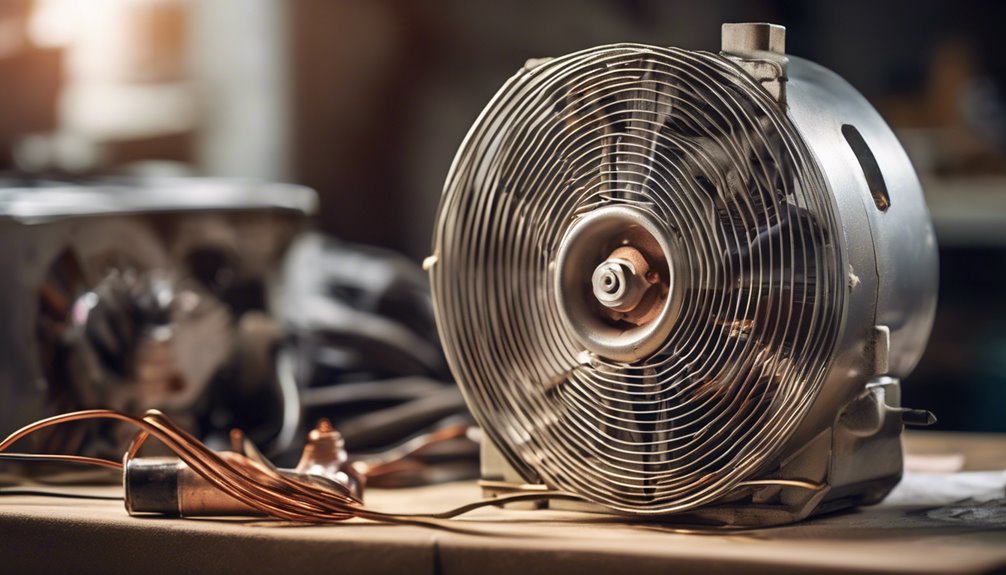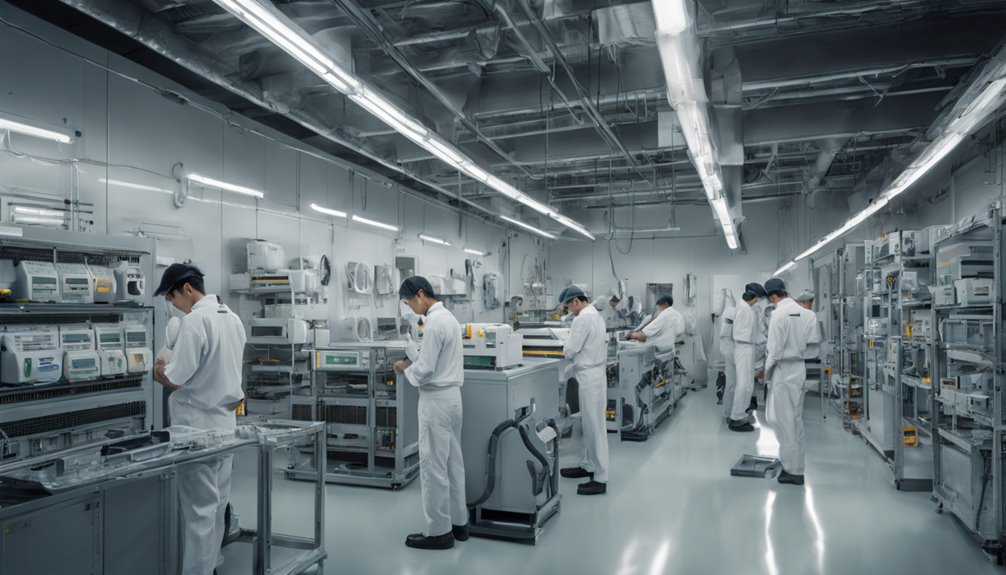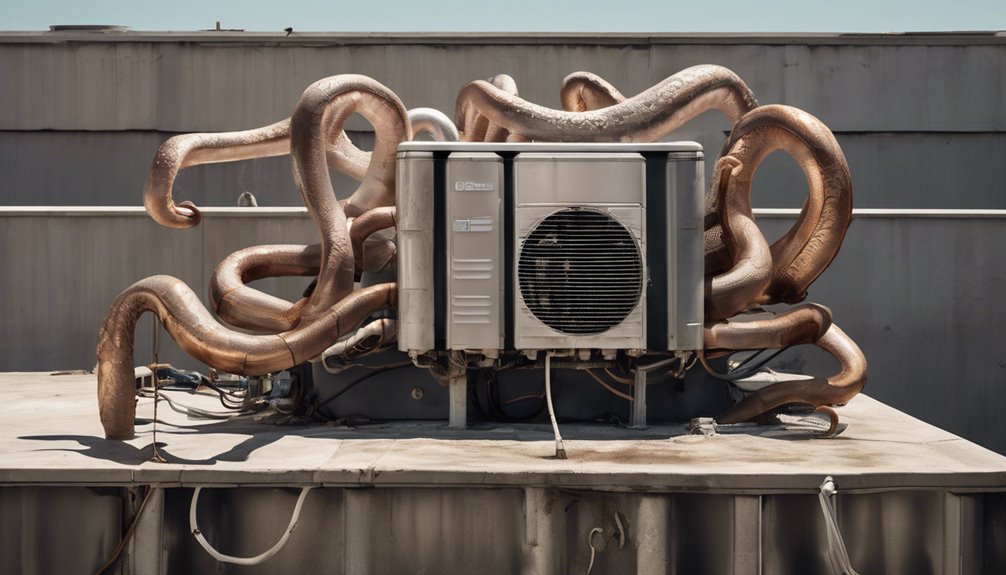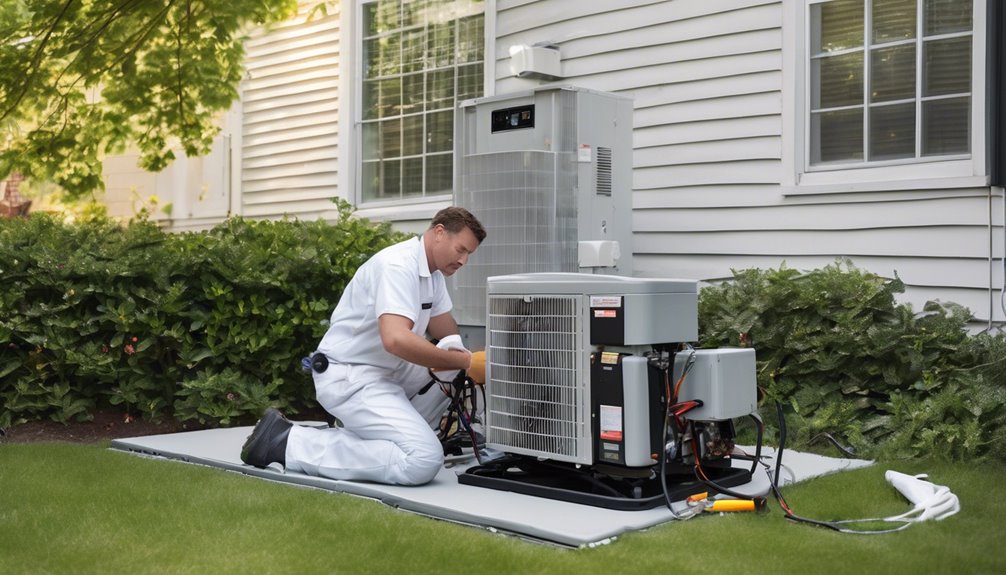When your AC's fan motor or blower breaks down, you'll likely notice reduced airflow, increased energy bills, or strange noises. These issues can lead to premature motor failure if left unaddressed. To avoid costly repairs, it's essential to identify the root cause of the problem through visual inspections, electrical testing, and circuit analysis. You can try DIY repairs like cleaning the fan blades and motor housing, but if you're unsure, it's best to call a pro. Continuing to explore these common issues and maintenance tips can help you get your AC running smoothly again.
Key Takeaways
- Regular maintenance, such as cleaning and lubricating, can extend the lifespan of AC fan motors and prevent costly repairs.
- Identifying and addressing motor issues early on, such as worn-out bearings or poor fan alignment, can save costly repairs or motor replacement.
- Overheating, unusual noises, and reduced airflow output are common symptoms of blower motor problems that require prompt attention.
- DIY repair options, such as cleaning or replacing the motor, should only be attempted if confident in abilities to avoid further damage or safety hazards.
- Visual inspections, electrical testing, and circuit analysis can help identify the root cause of AC fan motor and blower problems.
Common Issues With AC Fan Motors
When your air conditioner's fan motor fails, it's often due to one of several common issues.
One of the most frequent causes is worn-out motor bearings. Over time, they can become noisy, vibrate excessively, and eventually seize, bringing the motor to a halt.
Another common problem is poor fan alignment. If the fan blades aren't properly aligned with the motor shaft, it can put excessive stress on the motor, leading to premature failure.
You might also notice uneven airflow, increased energy bills, or strange noises before the motor gives out. Identifying and addressing these issues early on can save you from costly repairs or even a complete motor replacement.
Blower Motor Problems and Symptoms
As you troubleshoot your AC fan motor, you'll likely encounter some common blower motor problems and symptoms.
You might notice your motor is overheating, which can lead to premature failure.
You may also hear unusual noises or experience reduced airflow output, all of which warrant further investigation.
Motor Overheating Issues
Motor overheating issues are a common problem in AC fan motors, and they can be a real headache to diagnose and repair.
When your motor overheats, it can significantly reduce its lifespan. Temperature fluctuations can cause the motor to degrade quickly, leading to premature failure.
You might notice your AC fan motor running hotter than usual, or it might be producing less airflow. In some cases, you might even smell something burning.
If you suspect your motor is overheating, it's essential to address the issue promptly. Ignoring the problem can lead to costly repairs or even require a complete motor replacement.
Unusual Noise Generation
How does your AC fan motor sound lately? If you've noticed unusual noises, it's essential to investigate.
Abnormal sounds can indicate underlying issues that, if left unchecked, may lead to more severe problems or even complete motor failure. Unusual noise generation can be caused by misaligned or loose components, worn-out bearings, or faulty mounting systems.
To diagnose the issue, consider conducting a vibration analysis to identify the source of the noise. Noise mapping can also help pinpoint the location and severity of the problem.
Reduced Airflow Output
You've probably noticed that your air conditioner isn't blowing as strongly as it used to, leaving your home feeling stuffy and uncomfortable.
This reduced airflow output can be a sign of a failing blower motor. When your blower motor starts to wear out, it can't move as much air, resulting in poor air circulation throughout your home.
This can put extra strain on your ventilation systems, causing them to work less efficiently. As a result, you may notice that your home takes longer to cool down, or that some rooms feel warmer than others.
If you're experiencing reduced airflow output, it's essential to have your blower motor checked and repaired or replaced if necessary.
Identifying the Root Cause of the Problem
You'll need to identify the root cause of the problem to ensure a successful repair.
To do this, you'll follow a visual inspection checklist to look for signs of wear, damage, or corrosion.
Next, you'll use electrical testing procedures to verify your findings and pinpoint the exact issue.
Visual Inspection Checklist
Most AC fan motor repairs start with a thorough visual inspection to identify the root cause of the problem.
You'll want to examine the motor bearings, checking for signs of wear, rust, or scoring. Inspect the motor mounts, ensuring they're securely fastened and not damaged.
Next, inspect the wiring connections, verifying they're clean, tight, and free from corrosion. Check for any signs of overheating, such as melted insulation or burnt wires.
Look for signs of physical damage, like dents, cracks, or broken components. Finally, inspect the blower assembly, checking for blockages, dirt buildup, or worn-out components.
Electrical Testing Procedures
The electrical testing procedures are crucial in identifying the root cause of the problem, as they help isolate faulty components and pinpoint areas that require repair or replacement.
You'll need to perform voltage measurement tests to check for any electrical anomalies. This involves measuring the voltage supply to the motor and comparing it to the rated voltage.
You should also conduct circuit analysis to identify any issues with the wiring or connections. Use a multimeter to measure resistance, continuity, and voltage drop across different components.
DIY Repair Options for AC Fan Motors
When your AC fan motor breaks down, replacing it can be a costly affair, especially if you're not sure what's wrong with it.
Before calling a professional, you can try some DIY repair options. First, inspect the fan quality to see if it's clogged with dust or debris. Cleaning the fan blades and motor housing might resolve the issue.
If not, you may need to replace the motor. When selecting a new motor, ensure it matches the original's specifications and voltage requirements. Proper motor selection is crucial to avoid further damage or safety hazards.
When to Call a Professional for Blower Repair
Five common signs indicate you need professional help for blower repair: strange noises, burning smells, excessive vibration, reduced airflow, or complete motor failure.
If you're experiencing any of these issues, it's crucial to call a professional for assistance. Don't risk making the situation worse or causing further damage to your AC fan motor.
Don't risk making the situation worse, call a professional for assistance to prevent further damage to your AC fan motor.
Emergency situations like these require expert diagnosis and prompt attention. A professional can quickly identify the problem and provide a solution, getting your system up and running efficiently again.
They'll have the necessary tools and expertise to repair or replace the blower motor, ensuring your safety and comfort. Don't hesitate to seek help when you need it – your AC system will thank you.
Preventative Maintenance for AC Fan Motors
Regular maintenance is key to extending the lifespan of your AC fan motor and preventing costly repairs down the line.
By performing routine checks and tasks, you'll ensure your fan motor runs efficiently and effectively. This includes cleaning the fan blades and motor housing, checking for loose screws and worn belts, and lubricating moving parts.
Proper maintenance also helps maintain fan efficiency, allowing your AC to cool your space more effectively. Additionally, regular upkeep promotes motor longevity, reducing the likelihood of breakdowns and extending the time between replacements.
Troubleshooting Tips for Optimal Performance
Your AC fan motor is humming along smoothly, but suddenly, it starts making strange noises or failing to spin altogether.
Don't panic! It's time to troubleshoot the issue to ensure optimal performance of your cooling systems.
Check the motor's power supply and connections for any signs of wear or damage.
Make sure the motor is properly lubricated and clean.
If the issue persists, inspect the fan blades for blockages or misalignment.
A well-maintained motor is key to motor efficiency, so identify and address any problems promptly.
Frequently Asked Questions
Can I Repair My AC Fan Motor Myself to Save Money?
You're considering DIY repairs to save money, but be aware that motor troubleshooting can be tricky. Without expertise, you may cause more harm, leading to costly fixes or even safety risks, so it's essential to weigh the potential DIY challenges against professional help.
What Is the Average Lifespan of an AC Fan Motor?
You're wondering how long your motor will last. Generally, a well-maintained motor can run for 10-15 years, depending on motor durability and fan efficiency. In ideal conditions, it might even reach 20 years, but that's rare.
Will a Faulty Blower Motor Increase My Energy Bills?
If your motor's efficiency takes a hit, you'll likely see a spike in energy consumption, which means you'll be paying more on your energy bills. A faulty blower motor is no exception, so expect higher costs if you don't address the issue.
Can I Replace My AC Fan Motor With a Different Type?
When replacing a motor, you'll need to ensure the new one is compatible with your system. Look for motors meeting efficiency standards, like ENERGY STAR, to avoid voiding warranties or compromising performance, and consult a pro if you're unsure.
Are There Any Safety Risks Associated With Faulty Blower Motors?
When dealing with faulty motors, you're exposed to serious safety risks. You risk sparking fire hazards from overheated components or experiencing electric shock from short circuits, so it's crucial to address the issue promptly and correctly.
Conclusion
You've made it to the end of this guide, and now you're equipped to tackle common AC fan motor and blower issues. Remember to identify the root cause, consider DIY repairs, and know when to call a pro. Regular maintenance can prevent future problems, and troubleshooting tips will ensure optimal performance. By following these steps, you'll be breathing easy in no time, with a cool and comfortable home to enjoy.



